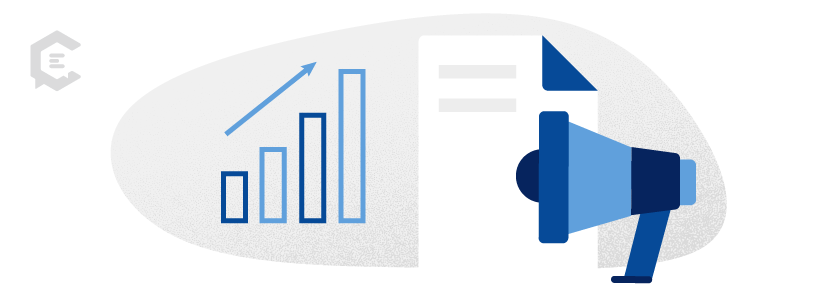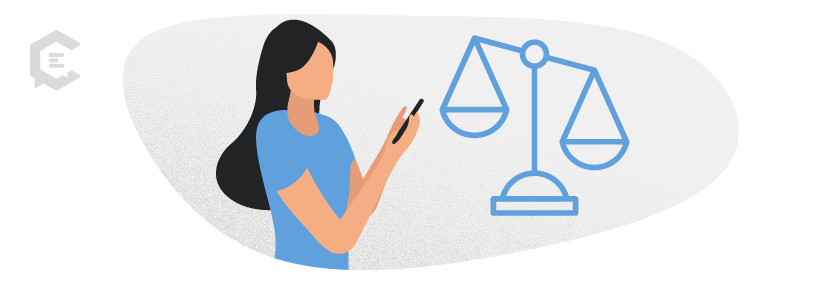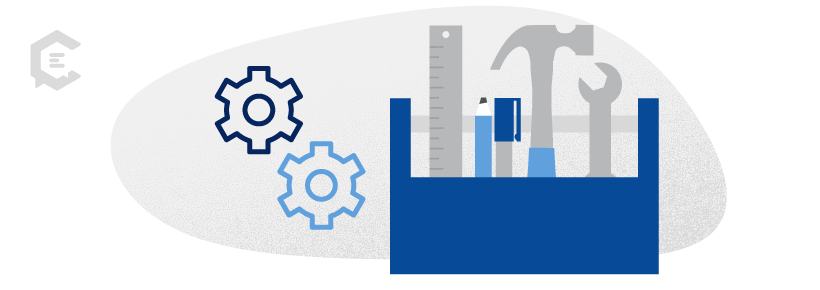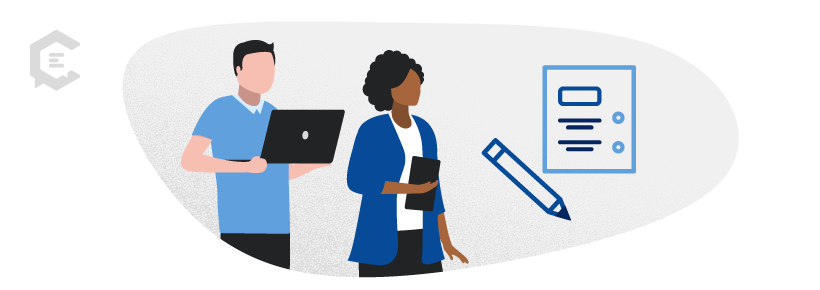Everyone has their favorite creative marketing moment. Seriously. Think about it.
The Haynes Baked Beans ad tops many-a-list. An astronaut cowers silently behind a moonrock as his compatriots get attacked by an alien — only to be betrayed by some poorly-timed flatulence. Or how about the infamous Wassup commercial from Budweiser? It left us all answering the phone with a loud and persistent “Wasssssup?” You get the message. (Well, we hope so.)
Creativity has always been the starlet of content creation. Meanwhile, behind the curtain, in a dark corner of the stage, analytics has been waiting for its moment in the limelight. With recent advances in marketing data analysis, analytics is poised to steal the show.
But are the two mutually exclusive? Not at all. This article explores the role of creativity vs. analytics, how to strike the ideal balance, and some tools to help you get it just right.
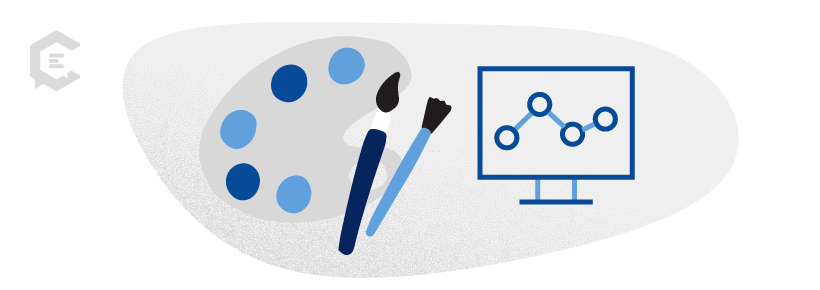
The Role of Creativity in Content Strategy
If your content is a meal, creativity is the seasoning. It turns bland information into an appetizing feast that keeps your audience coming back for seconds.
Benefits of creative input
A few sprinkles of creativity can also help:
- Establish your brand. You let your customers know that you don’t mind thinking outside the box, having a little fun, and pushing the boundaries — all of which imply that you’d be willing to take risks to earn and keep their business.
- Differentiate your brand. Stirring in some creativity sets your brand apart from the other options on the menu. Customers know they’ll have a unique, memorable experience.
- Boost engagement. Fun, intriguing, unique content whets your audience’s appetite, making them hungry for the next course, which could be a sale, more information, or repeat business.
- Your content —and brand — go viral. You’re not alone if you’d never heard of Haynes Baked Beans before their funky ad. Now, it’s probably the only brand of baked beans most people can name off the top of their heads. Going viral pays. It may not be a coincidence that Kraft Heinz (KHC), the parent company of Haynes Baked Beans, saw a 15 percent jump in its stock price as the ad went viral after its release in December 2013.
Challenges of Relying Solely on Creativity
Even the most creative content strategy can fail if it isn’t balanced with analytics. By using a purely creative strategy, you take a few different risks:
- Misinterpreting “good” ads as “effective” ads. Your audience may laugh, cry, or dance but not buy.
- Fostering a culture that values creativity more than data-based results.
- Diluting your brand’s perception in the market. Potential customers could see your company as fascinating but not necessarily a company they want to do business with.
And sometimes, when you rely solely on creativity, it may end up as a swing and a miss. For example, Adidas emailed customers who ran the Boston Marathon in 2017, saying, “Congrats, you survived the Boston Marathon!” Considering the murderous bombing that had just happened in 2013, the choice of words took “too soon” to another level, forcing an apology from Adidas.
The Importance of Analytics in Content Strategy
Analytics has become a foundational element of making informed, effective content decisions. By analyzing your target market’s demographics, tastes, and purchasing behaviors, you can systematically hone in on the most effective content for inspiring their patronage.
Advantages of Data-Driven Strategies
Data-driven strategies streamline the process of knowing who to direct your content to and its effect on them. Circling back to the cooking analogy, you can use analytics to determine the kinds of flavors your audience may enjoy, those they don’t like, and any potential “content allergies.”
For instance, when Dove ran an ad for its body wash featuring a black woman turning white, many people on social media called for a boycott due to the ad’s apparently racist overtones. It may have prevented a branding no-no if Dove had field-tested the ad across various communities and used analytics to study the resulting data.
Analytics also gives you actionable data that can support a variety of intelligent content decisions. For instance, with analytics, you can pinpoint:
- The kinds of content that have led to qualified leads or sales in the past
- Your audience’s age range and geographical location
- Click-through rates, impressions, and other data to gauge what has worked well in previous campaigns
Pitfalls of Over-Reliance on Analytics
At the same time, if you over-rely on analytics, you may sacrifice the spice. Analytics can tell you how old your target market is, where they work, and how long they spend on your website. But it may not point you in the right direction when it comes to what makes them laugh, think, or the specific business problem they’re facing.
To illustrate, your analytics reveal that B2B customers who receive emails twice a month tend to purchase more often than those who receive an email weekly. That could be useful data. Then, you create a series of emails that showcase product features but don’t appeal to the customer’s personal story.
It would be more effective to incorporate some storytelling, weaving in pain points, how your offering addresses them, the outcomes customers can expect, and how these earn them more money.
Achieving the Ideal Balance of Creativity vs. Analytics
Making sure your content is well done and using the right medium is rare, but the recipe for success may not be as elusive as many think. It involves mixing the input of your creative and analytical teams.
Collaborative Approaches Between Creative and Analytical Teams
Creativity vs. analytics doesn’t have to be an antagonistic debate. When your analytical and creative teams work together, you can create a content strategy that systematically supports success. Your analytical team tells you who to serve your content to, how they consume it, and how it affects their buying. Your creative team can take this data and decide which ingredients to mix into your content stew and how to spice it up to meet individual customer’s tastes.
In many situations, the analytical work may have to come first and last, creating an analysis-creativity-analysis sandwich. In other words, you analyze data to pinpoint your target market, create content for them, and then analyze how your content performed. In that way, analysis informs the creative process and enables you to study your approach’s effectiveness.
Case Study: 7speaking Learns How to Speak Customers’ LanguageLanguage-learning company 7Speaking chef’d up a filling analysis-creativity-analysis sandwich, and their target customers ate it up. The company wanted to generate more high-quality leads and boost general awareness and engagement with its target audience. 7Speaking’s marketing team first used data to decide who to serve their content to, choosing to target HR and training personnel in large enterprises. Their analysis also helped them decide which industry issues to address in their content. They then created accordingly. The process involved creating a mix of LinkedIn-sponsored and personalized messaging focused on unique business challenges. Combining analytics with creative storytelling paid off. After the campaign, analytics revealed they had scored over 800 qualified leads, had a click-through rate of three percent, and earned more than 10,000 views on 7Speaking’s landing pages. |
Tools and Technologies Supporting the Balance of Creativity vs. Analytics
There’s no shortage of tools for performing analytics, and while no tool can replace human ingenuity, you can use plenty of solutions to support the creative process. Here are some of the most popular options.
To generate useful analytics:
- Google Analytics. Get data regarding website traffic, audience demographic data, content performance, and user behavior.
- SEMrush. Analyze what your competition is doing, discover effective keywords, optimize content for search engines, and track how your pages are ranking.
- Analytics tools for social media. You can use Facebook Analytics or Twitter Analytics, for example, to track engagement, the demographics of the people you’re reaching, and the impact of your social media content.
To support the creative process:
- Adobe Creative Cloud. You get a comprehensive graphic design solution with tools like Illustrator and Photoshop.
- Grammarly. Grammarly helps you write clearer, grammatically accurate phrases and sentences.
- Canva. Canva has templates for creating social media graphics, advertisements, posters, and other marketing collateral.
The Future of Content Strategy: Creativity vs. Analytics
Blending creativity and analytics for effective content will continue to drive success in the days ahead. Tools that meld the two, such as AI solutions that can determine keywords based on demographic analytics, will become increasingly popular.
Also, as target audiences tire of the repetitive, predictable cadence and word choice of AI-generated content, human creativity will become even more crucial in the content creation process.
Use Analytics to Inform and Improve Your Creative Strategy
Encouraging collaboration between your analytical and creative teams allows you to get the best of both worlds. Striking an ideal balance involves using analytics to answer the questions, “Who should we present this to?”, “How?”, and “How effective was it?” You can use creativity to season your content dishes to perfection, making sure they appeal to your buyers’ tastes and clearly demonstrate the nutritional value of your product: its value-add in the context of your target customer’s needs.
ClearVoice’s experts can handle both the analytics and creativity you need for a winning content strategy. Talk with us today to get started.
